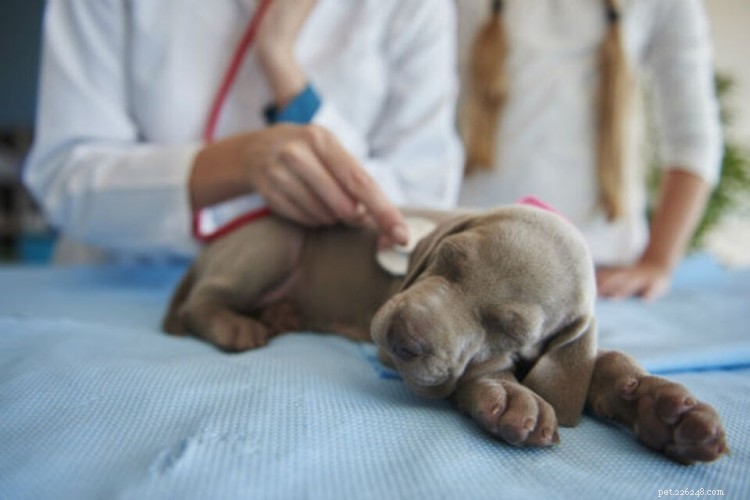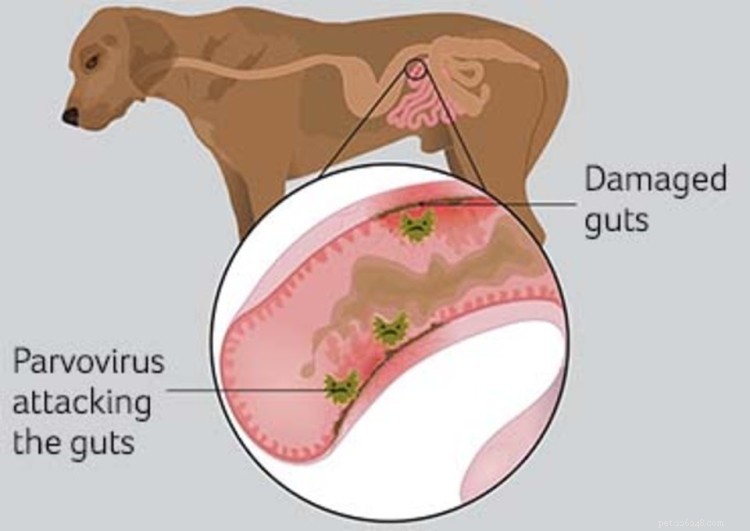I cuccioli sono molto suscettibili a molte malattie perché il loro sistema immunitario non è completamente sviluppato. Un esempio è il parvo, un brutto virus che attacca l'intestino causando grave diarrea, vomito e disidratazione. Parvo è molto contagioso e particolarmente pericoloso per i cuccioli non vaccinati di età inferiore ai sei mesi.
Questa guida ti dirà tutto ciò che devi sapere sul parvo nei cuccioli, inclusi i sintomi del parvo più comuni e i passaggi che puoi adottare per proteggere il tuo animale domestico da questa malattia potenzialmente mortale.
Suggerimento da professionista :L'assicurazione dell'animale domestico coprirà il parvo se il tuo cucciolo ha ricevuto tutte le vaccinazioni di routine. È meglio iscriversi prima che il tuo cucciolo sviluppi complicazioni di salute, altrimenti la condizione potrebbe non essere coperta.
Sommario:
Il parvovirus canino, noto come parvo o CPV, è un virus altamente contagioso che attacca il sistema gastrointestinale (GI) di cuccioli e cani giovani . Il virus può diffondersi facilmente attraverso il contatto con un cucciolo infetto o per contatto indiretto con un oggetto contaminato, come ciotole d'acqua, giocattoli e persino le mani degli esseri umani.
Il virus attacca lo stomaco e l'intestino tenue, distruggendo le cellule, alterando l'assorbimento dei nutrienti e distruggendo la barriera intestinale. Nei cuccioli, il parvo può interessare anche il tessuto linfopoietico e il midollo osseo. In alcuni casi, il parvovirus può infettare il muscolo cardiaco (CPV cardiaco ), che di solito è fatale ma molto meno comune.
Il virus è resistente al freddo e al calore con la capacità di sopravvivere fino a un anno all'aperto e cinque anni al chiuso. Il CPV è resistente all'alcool, ai detersivi e a molti disinfettanti, motivo per cui può essere difficile da contenere.
 (Fonte immagine:American Kennel Club)
(Fonte immagine:American Kennel Club)
I cuccioli sono esposti al parvo ogni volta che annusano, leccano o toccano feci infette, il che può essere particolarmente problematico per i cani giovani che esplorano il mondo con i loro sensi. La trasmissione del parvo nei cuccioli può verificarsi anche ogni volta che entrano in contatto con un oggetto o una persona contaminata nel loro ambiente. Anche le scarpe che calpestano le feci infette possono portare il virus in casa, dove può vivere nel terreno fino a un anno.
Sebbene tutti i cani siano a rischio, parvo è più comune nei cuccioli non vaccinati di età compresa tra i sei ei 12 mesi . Fortunatamente, i cuccioli di età inferiore alle sei settimane conservano ancora alcuni degli anticorpi della madre, a condizione che abbia ricevuto l'intero ciclo del vaccino. I genitori di animali domestici dovrebbero tenere presente che alcune razze corrono un rischio maggiore di contrarre il parvo, vale a dire:
Prendi ulteriori precauzioni per proteggerti dal parvo nei cuccioli che appartengono a queste razze.
I cuccioli con parvo iniziano a perdere il virus entro quattro o cinque giorni dall'esposizione, di solito prima che si sviluppino i segni clinici. Con l'inizio della malattia, alcuni dei sintomi di parvo più comuni nei cuccioli includono:
Se noti una delle bandiere rosse sopra, contatta il tuo veterinario il prima possibile . Assicurati di informarli in anticipo delle condizioni del cucciolo e delle tue preoccupazioni, in modo che il personale possa adottare le misure di quarantena necessarie per prevenire un'ulteriore trasmissione.
Innanzitutto, il tuo veterinario eseguirà esami del sangue per confermare che il tuo cucciolo ha parvo. The vet might also run an ELISA test to look for CPV antigens in the feces.
Parvo weakens a puppy’s immune system, lowers the white blood cell count, and damages the intestinal wall, reducing the pet’s ability to combat secondary bacterial infections. The mortality rate in canines that receive no treatment is over 90%, compared to 10-25% in those that are hospitalized . Therefore, hospitalization is strongly recommended for puppies with parvo symptoms.
Hospitalizing a puppy for parvo treatment costs about $2,000 to $3,000 just for the first day . Some patients might have to stay in the hospital for three to five days depending on the severity of the case (very sick puppies might stay in the hospital for up to ten days if they require intensive care).
Puppies infected with parvo will be placed in an isolation ward to prevent transmission between doctors, nurses, or other animals in the hospital. They will also receive IV fluids, pain medication, anti-nausea medication, and antibiotics. A nasogastric tube might also be necessary in order to provide nutritional support.
If hospitalization is not possible due to financial reasons, there’s an outpatient protocol that includes learning how to administer anti-nausea medication and IV fluids under the puppy’s skin, administering oral medications, and checking their temperature. Frequent vet visits will be necessary to check blood sugar levels and electrolytes on a daily basis. This option may not be possible depending on the severity of the infection.
Your vet will recommend an appropriate treatment for your puppy’s individual case and let you know which precautionary measures you should take in order to protect any other dogs and puppies in your home.
Pro tip :Treatment for parvo can require 10 days of hospitalization. Without pet insurance that could cost hundreds or even thousands of dollars. Luckily, routine puppy vaccinations, which can be covered through pet insurance plans, include vaccinations for parvo. These vaccinations require multiple shots and vet visits, so pet parents should take some time to compare pet insurance plans and find a policy that will cover this routine care.
 (Image source:PDSA)
(Image source:PDSA)
Most parvo patients recover if aggressive treatment is used and therapy is started before severe dehydration and septicemia occur. Most puppies that make it through the first three to four days will recover completely. Recovery usually takes about a week, but it depends on the severity of the case.
Some breeds, such as the Doberman Pinscher, English Springer Spaniel, and Rottweiler, have a significantly higher fatality rate than other dog breeds.
Puppies continue to shed the parvovirus for up to ten days after recovery, so make sure to keep any animals recovering from the virus away from unvaccinated or partially vaccinated dogs.
Parvovirus is preventable through vaccination . Puppies shoulbe be vaccinated against the virus every two to four weeks starting at six to eight weeks old, up until they are at least 16 weeks old. The last shot at 16 weeks is required for coonfidence in lasting immunity. Until the round of vaccines is complete, they should be kept away from public areas where other unvaccinated dogs could be, such as dog parks.
Ensure that all dogs in your home are vaccinated. It’s very important that female dogs receive a full series of parvo vaccines, as the young puppies depend on the dam’s antibodies in their first weeks of life. Pregnant females can also be boosted with a parvovirus vaccine 2-4 weeks before giving birth in order to transfer higher levels of antibodies to the puppies. Your vet will help you make the final decision about a vaccination schedule that best fits your pet.
You should also be extra careful when socializing your pet. Until puppies have received all of their vaccines, they should be allowed to come into contact with unvaccinated dogs. Avoid dog parks as well as other places where canines gather and try to socialize your puppy in less public environments such as your home.
The stability of the parvovirus in the environment makes it very important to properly clean and disinfect contaminated kennels, crates, bedding, and other areas where infected canines are kept in order to keep the spread under control. A solution of 1 gallon of water and 1/2 cup of chlorine bleach will disinfect water and food bowls, as well as other contaminated items. Your vet can provide specific guidance on cleaning and disinfecting agents for your home.